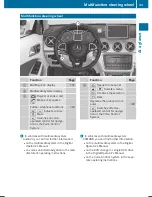
Only then can the forces which occur be dis-
tributed over the area of the belt.
R
the shoulder section of the belt is routed
across the center of your shoulder
The shoulder section of the seat belt should
not touch your neck or be routed under your
arm or behind your back. Where possible,
adjust the seat belt to the appropriate
height.
R
the lap belt is taut and passes across your
lap as low down as possible
The lap belt must always be routed across
your hip joints and not across your abdo-
men. This applies particularly to pregnant
women. If necessary, push the lap belt down
to your hip joint and pull it tight using the
shoulder section of the belt.
R
the seat belt is not routed across sharp,
pointed or fragile objects
If you have such items located on or in your
clothing, e.g. pens, keys or eyeglasses,
store these in a suitable place.
R
only one person is using a seat belt
Infants and children must never travel sit-
ting on the lap of a vehicle occupant. In the
event of an accident, they could be crushed
between the vehicle occupant and seat belt.
R
objects are never secured with a seat belt if
the seat belt is also being used by one of
the vehicle's occupants
Also ensure that there are never objects
between a person and the seat, e.g. cush-
ions.
Seat belts are only intended to secure and
restrain vehicle occupants. Always observe the
"Loading guidelines" for securing objects, lug-
gage or loads (
Y
page 250).
Fastening and adjusting the seat belts
Observe the safety notes on the seat belt
(
Y
page 41) and the notes on correct use of
seat belts (
Y
page 42).
Basic illustration
X
Adjust the seat (
Y
page 92).
The seat backrest must be in an almost
upright position.
X
Pull the seat belt smoothly from the belt
outlet.
X
Engage seat belt tongue
;
in belt
buckle
:
.
X
If necessary, pull up on the shoulder section
of the seat belt to tighten the belt across
your body.
The shoulder section of the seat belt must
always be routed across the center of the
shoulder. Adjust the belt outlet if necessary.
X
To raise: slide the belt outlet up.
The belt outlet will engage in various posi-
tions.
X
To lower: hold belt outlet release
=
and
slide the belt outlet down.
X
Let go of belt outlet release
=
in the
desired position and make sure that the belt
outlet engages.
All seat belts except the driver's seat belt are
equipped with a special seat belt retractor to
securely fasten child restraint systems in the
vehicle. Further information can be found
under "Special seat belt retractor"
(
Y
page 54).
Releasing seat belts
!
Make sure that the seat belt is fully rolled
up. Otherwise, the seat belt or belt tongue
will be trapped in the door or in the seat
mechanism. This could damage the door,
the door trim panel and the seat belt. Dam-
aged seat belts can no longer fulfill their
protective function and must be replaced.
Visit a qualified specialist workshop.
Occupant safety
43
Safety
Z
















































